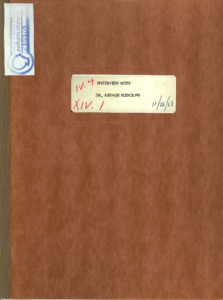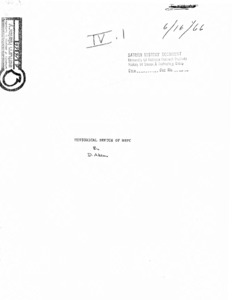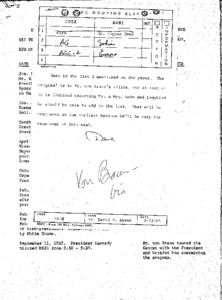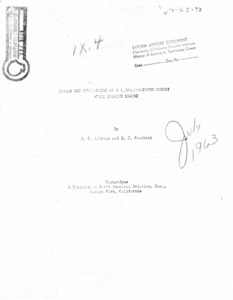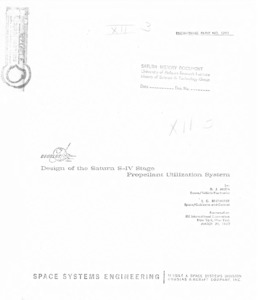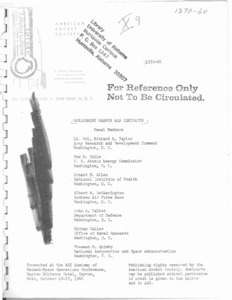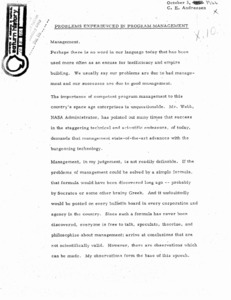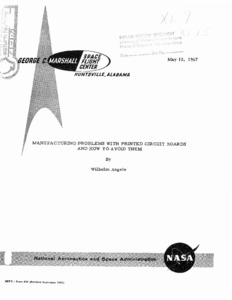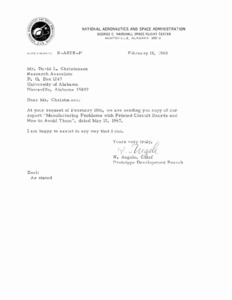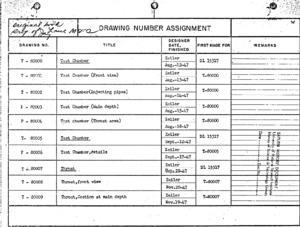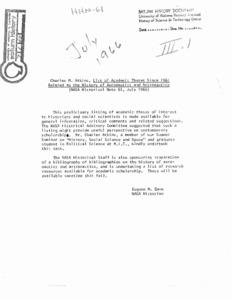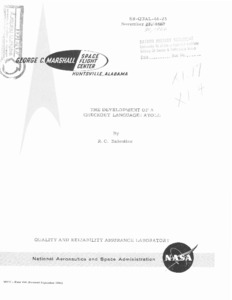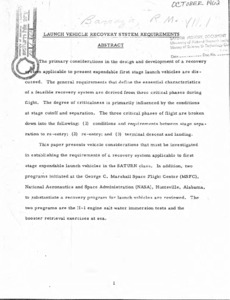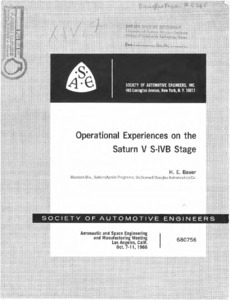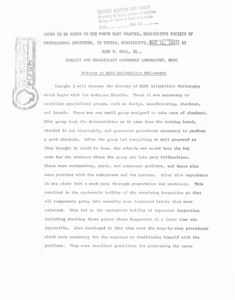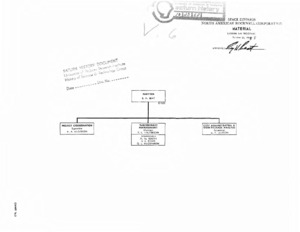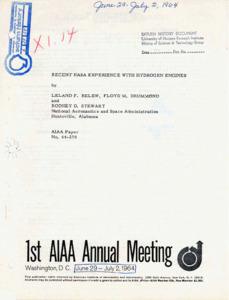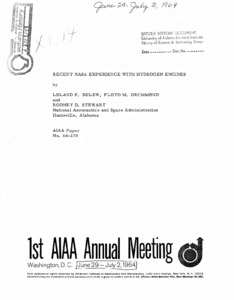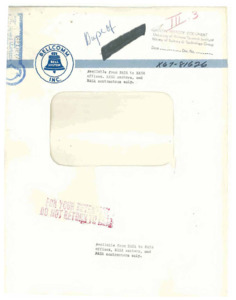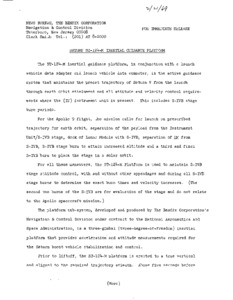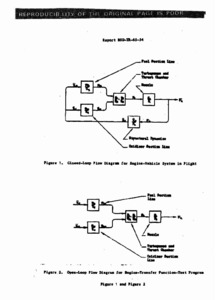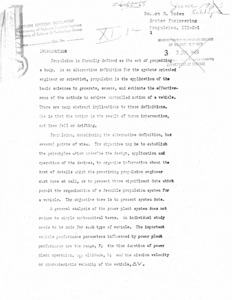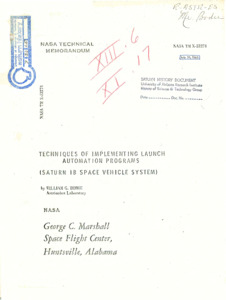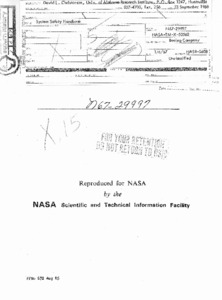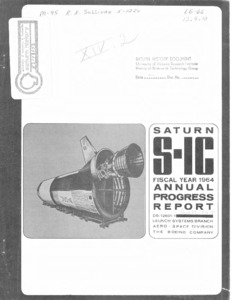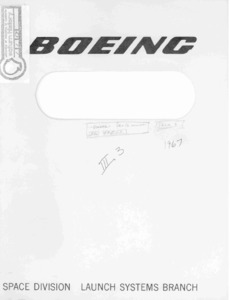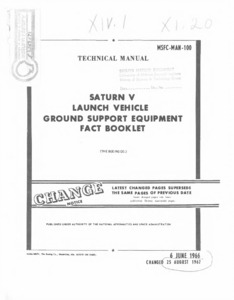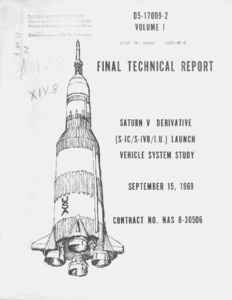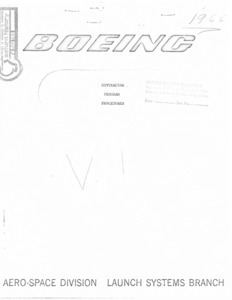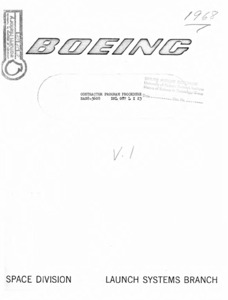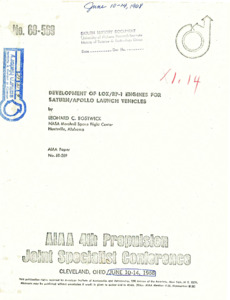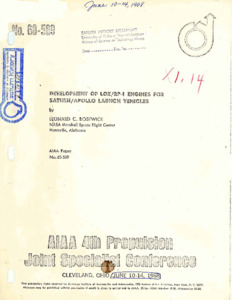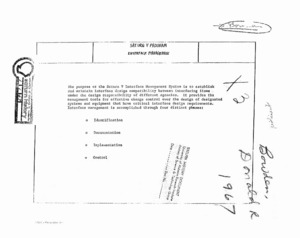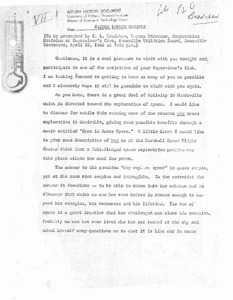
Browse Items (716 total)
Sort by:
-
"Interview With Dr. Arthur Rudolph."
Transcription of an interview between Davis S. Akens and Arthur Rudolph -
"Historical Sketch of MSFC."
A rocket from the George C. Marshall Space Flight Center will carry the first American to the moon, and the deadline is 1970. Because of the Center's expanding role in space, there are increasing requests for information about our activities. This brief historical sketch should help to answer questions about our past, our present, and our hopes for the future. Marshall Space Flight Center (MSFC) is the largest installation of the National Aeronautics and Space Administration (NASA). The Marshall Center is NASA's agency responsible for large space rockets and related research. MSFC employs about 7500 civil service employees with an annual payroll of more than {dollar}82 million. In addition approximately 4300 contractor employees work for MSFC on the Arsenal, earning an estimated {dollar}43 million. The Center occupies about 1800 acres near Huntsville, Alabama; in this large area are 270 buildings with floor space totalling about 4,000,000 square feet for a real estate and property value of about {dollar}325 million. MSFC's 1966 fiscal year budget was {dollar}1.8 billion. Obviously MSFC has much human and monetary worth behind United States round trips to the moon and beyond. In addition to its size, MSFC is unique because it has a large rocket development team with more than three decades of experience. Prior to the rocket work that dates back to Peenemuende [sic] the world heard little and cared less concerning rockets and space. As a group Marshall has always thought big. It has worked together as a group, and equally well with fellow scientists throughout the Free World, to get the most into space soonest. This is why there is increasing interest in larger and larger rockets and rocket programs from our Center, a fact generating more and more questions about our Center, and in turn generating a "workload" request for this sketch by the Historical Office. We hope that you enjoy our historical sketch, which could as well be entitled "Closer and Closer Views of the Moon and Beyond." David S. Akens, MSFC Historian. -
Dr. von Braun's calendars and scrapbooks indicate that these were his personal contacts with President Kennedy, Vice-President Johnson and members of their immediate staff.
The first page contains a typed routing slip. A list of Wernher von Braun's meetings with President Kennedy, the Vice President and members of their immediate staff. -
"Design and Development of a 1,500,000-Pound-Thrust Space Booster Engine."
Describes the F-1 engine design and components. -
"Design of the Saturn S-IV Stage Propellant Utilization System."
Describes the SIV vehicle and its components. Presented at: IRE International Convention. -
"Government Grants & Contracts."
The Army medical contract, grant, and research interest in the bio-science area. -
"Instrumentation Programming for Computer Controlled Digital Data Processing."
A number of considerations are necessary in instrumentation programming, many of which are either not applicable or applicable to a lesser degree in other types of programming. This paper discusses these problems in general terms and illustrates how they have been dealt with specifically. The latter is done by describing the programming and operation of a data reduction system. -
"Problems experienced in program management."
Letter to "management" detailing problems identified in management's handling of projects. -
"Manufacturing problems with printed circuit boards and how to avoid them."
To be presented at the NASA / Rocketdyne Manufacturing Technology Review. Focuses on how best to avoid printed circuit boards. -
"Letter to Mr. David L. Christensen."
Letter David L. Christensen from W. Angele responding to a pervious request. -
"Drawing number assignment"
The document is a photocopy of the Drawing Number Assignments from August 1947 to May 1953. Categories include but are not limited to the drawing number, title, designer, and date finished. Inscribed on the front is "original book property of Jay Laue, MSFC." -
"List of Academic Theses Since 1961 Related to the History of Aeronautics and Astronautics."
This preliminary listing of academic theses of interest to historians and social scientists is made available for general information, critical comments and related suggestions. The NASA Historical Advisory Committee suggested that such a listing might provide useful perspective on contemporary scholarship. Mr. Charles Atkins, a member of our Summer Seminar on "History, Social Science and Space" and graduate student in Political Science at M.I.T., kindly undertook this task. The NASA Historical Staff is also sponsoring preparation of a bibliography of bibliographies on the history of aeronautics and astronautics, and is undertaking a list of research resources available for academic scholarship. These will be available sometime this fall. Eugene M. Emme, NASA Historian.; NNH-61.; FOREWORD: This listing represents a first attempt to compile academic theses of relevance to the history of aeronautics and astronautics. It has been estimated that almost 70,000 doctoral dissertations have been completed in American universities since 1961, so this select compilation must be regarded as preliminary. In accord with the desire of the Historical Staff of the National Aeronautics and Space Administration to assist scholarly research, it is hoped that this list may be suggestive. It will, hopefully, stimulate a response which will permit additions to this listing of interest to historians and other scholars concerned with science, technology, and public policy in the twentieth century. -
"The development of a checkout language : ATOLL."
ATOLL was developed to fulfill the requirements for a common computer language that could be used by the test engineers for launch and factory checkout. "ATOLL" is the abbreviated name for Acceptance, Test, Or Launch Language. -
"Launch Vehicle Recovery System Requirements."
The primary considerations in the design and development of a recovery system applicable to present expendable first stage launch vehicles are discussed. The general requirements that define the essential characteristics of a feasible recovery system are derived from three critical phases during flight. The degree of criticalness is primarily influenced by the conditions at stage cutoff and separation. The three critical phses of flight are broken down into the following: (1) conditions and requirements between stage separation to re-entry; (2) re-entry; and (3) terminal descent and landing. -
"Failure Investigations of Large Liquid Propelled Rocket Engine Components."
Case histories of seven typical failures in large liquid propelled rocket engines components have been prepared. Quite simple to complex investigations are presented covering a variety of failure modes in a variety of materials. Included are successful solutions to the failure problems investigated.; Archive copy is a poor photocopy. -
"Operational Experiences on the Saturn V S-IVB stage."
This paper presents a light, but reverent, discussion of some of the Douglas operational experiences on the Saturn V/S-IVB stage. Certain relevant aspects of earlier work on the Thor intermediate range ballistic missile, the Saturn I S-IV stage, and the Uprated Saturn I S-IVB stage are also discussed.; Aeronautic and Space Engineering and Manufacturing Meeting, Los Angeles, Calif., Oct. 7 - 11, 1968. -
"History of MSFC Reliability Philosophy."
Paper given to North East Chapter , Mississippi Society of Professional Engineers. Essay discussing the history of the MSFC Reliability Philosophy. -
"Material : Saturn S-II program."
Saturn S-II Program Organizational chart. -
"Vibration and acoustic environment characteristics of the Saturn V launch vehicle."
This paper presents representative examples of vibration and acoustic data from flights of the Saturn V launch vehicle and static firings of Saturn V launch vehicle stages. The purpose of the paper is to provide vibration and acoustic environment characteristics which are pertinent to the design of launch vehicles -
"Recent NASA experience with hydrogen engines."
This paper presents a review of the experience which has accumulated in the development of the Liquid Hydrogen J-2 and RL10 rocket engines. These engines are being developed by the Rocketdyne Division of North American Aviation and Pratt & Whitney Aircraft, a Division of United Aircraft Corporation respectively.; On NASA Technical Reports Server (NTRS) as Unclassified; No Copyright; Unlimited; Publicly available. Also found on AIAA site. -
"Recent NASA experience with hydrogen engines."
This paper presents a review of the experience which has accumulated in the development of the Liquid Hydrogen J-2 and RL10 rocket engines. These engines are being developed by the Rocketdyne Division of North American Aviation and Pratt & Whitney Aircraft, a Division of United Aircraft Corporation respectively.; On NASA Technical Reports Server (NTRS) as Unclassified; No Copyright; Unlimited; Publicly available. Also found on AIAA site. -
"Preliminary skeletal operations plan for Apollo :" a systems engineering support document.
The Preliminary Skeletal Operations Plan is a statement of the operational concept for Apollo. This draft contains a description of the conduct of the Apollo LOR landing mission and a mission profile. It provides the basis for more detailed mission planning, for generating functional criteria for equipment design, and for measuring the adequacy of the current Apollo hardware for satisfying operational needs. -
Differences of configuration in successive Saturn IB and Saturn V vehicles- case 330.
Includes memorandum for file. Configuration matrices reflecting present program status of differences in Saturn IB and Saturn V flight hardware on a mission to mission basis have been prepared. The attached matrices are arranged to show differences in major subsystems (Structures, Propulsion, Instrumentation and Range Safety, and Electrical) for each stage. The reason for the configuration difference and the mission effectivity are included.; DMD, 2031-SGE-eas, GRH; Includes "Recommendation for announcement and distribution of Bellcomm Report". -
"Saturn ST-124-M inertial guidance platform."
a press release which focuses around the Apollo 9 flight and what role the ST-124-M inertial guidance platform has in it. -
"Pogo analysis of the Saturn Propulsion System."
Report that contians images of graphs, photographs and diagrams. -
"System engineering propulsion, III-C-1."
Page numbering is inconsistent; there are no pages numbered 14 - 17. Some pages have handwritten numbers, others have no numbers at all.; The print quality of many pages is poor. Discusses the definition and function of propulsion as well as how to most effectively employ it . -
"Techniques of implementing launch automation programs" (Saturn IB space vehicle system).
This paper identifies the methods and equipment through which automation is becoming a major factor in testing and launching Saturn IB space vehicles. The merits of a digital guidance computer and its impact in extending automated checkout are stressed; also a logical basis is established for computer and manual test control. Hardware and software elements of the automated system are described, and details pertaining to reliability are emphasized. A concluding appraisal suggests that automation will play an expanding role in future test and launch operations. -
"System safety handbook."
The testing of a hardware system consists of' subjecting it to carefully controlled operating conditions for the purpose of demonstrating that this system performs its function properly. -
"Saturn S-IC annual progress report, 1964."
This report encompasses the progress made by The Boeing Company on the Saturn S-IC Program for the fiscal year 1964 (From July 1, 1963 through July 2, 1964). The main objective of this report is to serve as an historical presentation stressing Boeing accomplishments and present capabilities under Contract NAS8-5608. -
"Saturn S-IC annual progress report, 1965."
This Annual Progress Report has been prepared by the Boeing Company to fulfill the requirement under Article XXX, Paragraph A and C, Modification 100 of Contract, NAS8-5608 as amended by NASA letter I-MICH-DB, dated May 19, 1965, B. H. Aldridge to E. S. Olason. Subject: Change of NAS8-5608 to incorporate Quarterly Technical Progress into the Annual Progress Report. -
"D5-13197 manufacturing plan: AAP."
This Manufacturing plan is prepared in response to the Apollo Applications Program request for proposal No. 1.1.; PURPOSE: The purpose of this document is to present a Boeing plan for the manufacturing effort required to provide hardware and support for the installation and checkout of Experiment Packages and related equipment in the Apollo Systems Modules. -
"Saturn V first stage annual progress report : fiscal year 1966."
This report is the consolidation of D5-11994, "Quarterly Technical Progress Report," for the fourth fiscal quarter and the fiscal year 1966 Annual Progress Report and places special emphasis on activities on the fourth fiscal quarter. -
"Saturn V launch vehicle ground support equipment fact booklet."
This booklet has been prepared to provide a quick reference to Saturn V stage peculiar ground support equipment. It consists of visual presentations and a brief description of each major component. It is intended to quickly familiarize concerned elements with the over-all MSFC launch vehicle ground support equipment and is not intended for design usage. The booklet has been prepared in five sections. Section I contains the introductory material and a description of the Saturn V mobile launcher (ML). Section II contains information on the umbilical equipment. Section III contains information on the servicing equipment, both fixed and mobile. Section IV contains information on the access equipment. Section V contains information on the handling and auxiliary equipment. -
"Final Technical Report: Saturn V Derivative (S-IC/S-IVB/I.U.) Launch Vehicle System Study: Volume I."
Technical report for September 15th, 1969. -
"Contractor Program Procedures".
A collection of various procedures. Archive copy is a photocopy. There is no continuous numbering in this document. -
"Contractor Program Procedure".
Outlines various procedures for Saturn V contractors. -
"Development of LOX/RP-1 Engines for Saturn/Apollo Launch Vehicles."
The development of liquid rocket engines follow similar patterns regardless of engine size. During the development of the H-1 and F-1 engines, many problems were encountered. Methods of solving the combustion instability problem are discussed. A description is given of the major components of each engine, outlining their unique features. The requirements for an insulation cocoon are discussed. Problems associated with materials substitution are provided; also highlighted is the fact that problems occur after engine deliveries and require continued development support. Safety features incorporated on the engines are mentioned. Solution to problems encountered in flight are discussed. Upratings of both engines systems are presented graphically.; On the NASA Technical Reports Server (NTRS) unclassified. Can also be found on AIAA. -
Development of LOX/RP-1 engines for Saturn/Apollo launch vehicles.
The development of liquid rocket engines follow similar patterns regardless of engine size. During the development of the H-1 and F-1 engines, may problems were encountered. Mehtods of solving the combustion instability problem are discussed.; AIAA 4th Propulsion Joint Specialist Conference, Cleveland, Ohio, June 10-14, 1968.; Also available on NASA Technical Reports Server (NTRS) as unclassified. Can be ordered. Also on AIAA. -
"Saturn V interface management."
The purpose of the Saturn V Interface Management System is to establish and maintain interface design compatibility between interfacing items under the design responsibility of different agencies. It provides the management tools for effective change control over the design of designated systems and equipment that have critical interface design requirements. -
"Saturn launch vehicle presentation."
Speech to be presented by C. L. Bradshaw, Deputy Director, Computation Division at Supervisor's Club, Knoxville Utilities Board. Speech praising the progress of space-based technologies and advancements.
